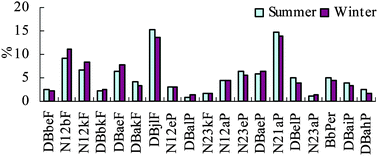Daytime and nighttime PM2.5 samples were collected between August 5 and 16, 2009 and between January 24 and February 4, 2010 in an industrial complex site (site A) and an electronic waste recycling site (site B) to determine the seasonal and diurnal variations of 19 individual polycyclic aromatic hydrocarbons (PAHs) with molecular weight 302 (MW302) including four highly carcinogenic dibenzopyrene (DBP) isomers dibenzo[a,l]pyrene (DBalP), dibenzo[a,e]pyrene (DBaeP), dibenzo[a,i]pyrene (DBaiP), and dibenzo[a,h]pyrene (DBahP). This is the first report on DBP isomers in air particles from South China. The total concentration of PAH MW302 isomers ranged from 1.65 to 3.60 ng m−3 in summer and 3.82 to 9.81 ng m−3 in winter. The strongest peaks in the chromatograms of the MW302 isomers were naphtha[2,1-a]pyrene (N21aP), dibenzo[j,l]fluoranthene (DBjlF), naphtha[1,2-b]fluoranthene (N12bF), naphtha[1,2-k]fluoranthene (N12kF) and dibenzo[a,e]fluoranthene (DBaeF), constituting 52.0 to 55.4% of the total MW302 isomers. All the MW302 isomers showed notable seasonal variations. Most of the MW302 isomers in site B showed distinctive diurnal variations with higher concentrations occurring in the night. Taking into account both concentration and potency equivalence factors (PEFs), the strongest carcinogen in the analyzed samples was DBaiP, and the ratios of sum carcinogenic potency of four highly carcinogenic DBP isomers to benzo[a]pyrene (BaP) was about 0.94 in winter to 1.89 in summer, indicating the importance of DBP isomers for the risk assessment. Health risk assessment indicated that on average, 1 in 100 000 residents in the two industrial sites may have an increased risk of cancer due to PAH exposure.


 Please wait while we load your content...
Please wait while we load your content...